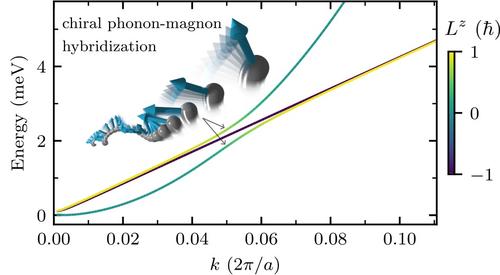Magnetism gives phonons a twist - TRR 227 results published in Phys. Rev. Lett.
Lattice vibrations with a handedness are promising for innovative applications in information processing, yet they have remained elusive. New research performed within the TRR 227 by Mercator Fellow Peter Oppeneer and coworkers uncovers a previously unknown mechanism to generate such lattice vibrations with a twist.
News from Nov 18, 2025
In most textbooks, lattice vibrations inside crystals – called phonons – are shown as atoms moving back and forth along straight lines. In a new study, Markus Weißenhofer (FU Berlin), Peter Oppeneer (Uppsala University, MF) and colleagues reveal that there can be a surprising twist: in magnetic materials, atoms don’t just vibrate – sometimes they even revolve circularly around their equilibrium positions. These swirling vibrations carry angular momentum and are commonly known as chiral phonons.
Lattice vibrations with a handedness have been previously predicted and observed in nonmagnetic low-symmetry crystals wherein absence of inversion-symmetry is essential for their occurrence. The work of Weißenhofer and colleagues reveals now that chiral phonons can appear, too, in perfectly symmetric magnetic crystals. Key to their appearance is the hybridization between the quantized spin waves – called magnons – of the magnetic material and the lattice vibrations.
Using a novel, first-principles-based framework, Weißenhofer et al show that magnons couple selectively to phonons of a specific chirality, or handedness, while largely ignoring those of the opposite sense, thereby endowing the coupled phonon modes with angular momentum. This selective coupling further allows the chirality of phonon modes to be tuned or even reversed by changing the direction of the material’s magnetization, for instance through an external magnetic field. The newly uncovered mechanism is general and expected to occur in many magnetic materials.
Chiral phonons have recently come in the focus of attention for their potential application in next-generation spintronic and phononic technologies. By uncovering a new and likely widespread mechanism for their emergence in magnetic materials, this research work greatly broadens the landscape of candidate materials and opens for exciting opportunities to harness chiral vibrations in magnetic materials for novel energy and information processing applications.
Figure caption:
Magnon energy band (light blue line) and phonon energy bands (yellow and purple lines) of magnetic iron, shown as function of momentum vector k. Hybridization between the magnon mode and one phonon mode (yellow line) makes the phonon modes chiral with angular momentum Lz.
Original publication:
Chiral phonons arising from chirality-selective magnon-phonon coupling
M. Weißenhofer, P. Rieger, M. S. Mrudul, L. Mikadze, U. Nowak, and P. M. Oppeneer
Phys. Rev. Lett. 135, 216701 (2025) - DOI: 10.1103/j7bs-2zbx

